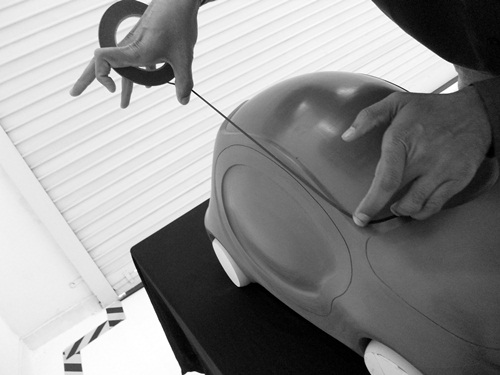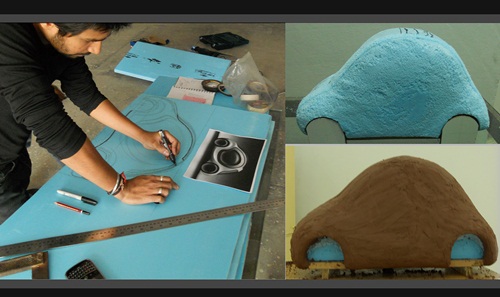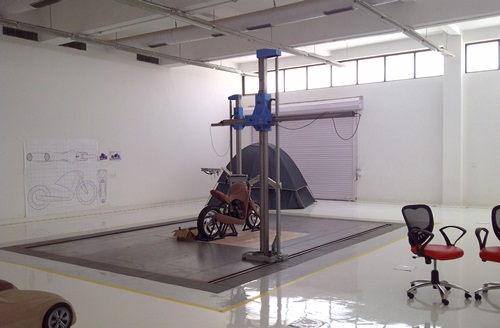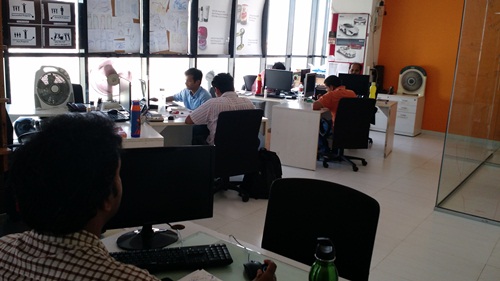Anuj Prasad is a leading designer and an alumnus of the National Institute of Design (NID), having completed his masters in product design in 1993. An engineer by profession, he is now better known as a design entrepreneur. And the engineer-designer is also an artist, whose paintings reflect the vibrancy of form and colour.
A founding member of the National Committee of Design of the Confederation of Indian Industry (CII), he has been a jury member of the ‘India Design Mark’ since inception.
Prasad, the founder and CEO of Desmania, one of the top industrial design studios in India, with its head office in Gurgaon, talks to Nithin Rao on the growing importance of the design industry in India, especially in sectors such as automobiles and urban planning.
What are the major developments in the Indian design industry and cutting across various sectors including industrial, architectural, interior, landscape, furniture, fashion, leather, retail and graphic and animation?
Indian industry has evolved rapidly in the post-liberalisation era. Consumer demand and increasing spending power has been instrumental in this major shift. With rising incomes and expanding middle class, the markets have over-flooded with products that entice the consumer for a better lifestyle or sheer consumption to feel good. This revolutionary change in consumer behaviour has given a great impetus to design for differentiation.
The industry has lapped the demand by increasing production and enhancing variety to cater to the tastes of the new generation. With the widespread penetration of TV with multiple channels, the consumer has gained unprecedented importance in the mind of producers. This has led to a consistent growth in GDP.
The landscape has suddenly become very fertile for the designers. Their talent is being utilised for one-upmanship of all kinds of manufacturers. Also, the accessibility of design, with a growing availability of talent, is seen as a major catalyst in the choice available for the consumer. The market is vibrant now and will continue to remain so.
E-com companies have further added fuel to the fire by creating an impulsive buying culture, to meet the aspirations of the middle-class.
The times ahead portend more production, more design and more consumption. Only thing that we need to be careful about is the sustainability. Our country cannot afford unabashed growth at the cost of the environment. Our resources are limited, and designers need to inculcate this challenge in their process.
Is there growing awareness in India - among manufacturers and service providers and consumers - on the importance of designs in the products and services that are marketed today?
Design is becoming the biggest differentiator and is at the helm of product development. Manufacturers and service providers have recognised that a great product without a great design is a doomed offering. They are very well aware that in a crowded market where functionality is taken for granted, it is design which swings the decision making. Many pre-and post-launch research for the new products have affirmed this fact.
Consumers have also shown a deep inclination towards products that reflect empathy for their desires and problems. Apart from imparting aesthetics to the products, design is also a great tool to solve consumer/user problems which have origin from their socio-cultural-economic background.
Last but not least, brands are gaining ground in consumers mind. Design plays a major role in creating perception about a brand. This is both at a visual and emotional level. In reality, design is the mother of all trusted brands. Now companies vouch for the deeply researched design that has user-centric features.
The same phenomenon has taken place in the digital space. The online apps circle around the ease of use, look and feel and user stereotypes.
Do you see a gradual decline in the churning out of shoddy products by manufacturers as a consequence of growing awareness about the importance of designs?
Though we still have a long way to go, the green shoots are visible. Shoddy designs are disastrous for business. Manufacturers, large and small, are getting a taste of design through business success. Now they use design as a tool to meet their business objectives. Yet, design is still at a fledgling state and there is enough scope to dig deeper to unearth its real value. It is value, perceived and experienced, that is the key to a good design.
Indian consumers face a lot of problems while handling products including sachets, food and drink packets (even on flights), and packages containing products couriered to them. However, many companies and brands are still not conscious of the need to design products that are consumer-friendly. What are the reasons for this gross negligence?
Packaging is one of the first early adopters of design. Unfortunately, the connotation of packaging design is either to attract the consumer or just to protect the content. Usability of packaging is not yet fully exploited. This is the main reason that many products have frustrating packing from the consumer’s perspective. It is true that sachets, bottle caps, etc are a struggle to open.
FMCG companies work on a basic premise to cut cost because of its magnifying effect on savings and increased profitability. Nevertheless, with the growing competition, they have no choice but to invest in user friendly packaging. Problem solving for opening and dispensing has only touched the tip of the iceberg. Also, environment friendly packaging is being thrust upon these manufacturers through policies and regulation.
I have seen that most of the big brands are now revisiting their packaging design to solve both of the above problems. It will be prudent for them to make investments that reduce material, solve user problems and explore the possibility of using green materials and substrates. Inclusive packaging should integrate all these three elements of design.
The automobiles sector in India has seen a lot of developments in the designing of vehicles. But besides cars, do you see commercial vehicles also becoming consumer-friendly in terms of designing over the coming years?
Sale of personal vehicles (PVs) is driven by the combination of design, brand, price and performance. Not necessarily in the same order, but definitely design as a precursor. OEMs are trying to create emotional connect with the customers through technology integration and feature based design.
Tata Motors, for instance, has seen a surge in sales because its new cars resonate with the new generation’s desires. It has been primarily driven by design. Overwhelming acceptance of design in the PV segment is largely because customer is also the user and he considers design as a reflection of his personality.
In the Commercial Vehicle (CV) segment, the customer is seldom the user. Price plays a big role in determining the buy. User comfort (read driver comfort) is never the priority for the buyer. Hence design is limited to the surface level of differentiation. In the developed markets, where the user (driver) is more evolved, manufacturers have been giving a similar design treatment to the CVs as in PVs. With the advent of brands like Volvo, Daimler, Scania, etc. in the CV segment, there is growing awareness among the Indian manufacturers to differentiate through design not only styling but also through experience (comfort in the interiors).
With the rapid growth in demand for low-cost housing, do you see designers stepping in and helping builders in developing affordable, yet attractive flats?
Urbanisation and smart cities concept is getting the traction that it deserved. Urban poor were a neglected lot until now, but with mass scale migration to urban centres, it is imperative that a large consumer base is getting ready for spending. However, pricing and affordability are the key challenges for the real estate industry. At the same time shrinking resources of water and land are forcing them to innovate on housing.
Still, housing and urban planning is the domain of architects. Mostly they are yet to accept the fact that designers can add value and help them in innovating better eco-systems. Value creation is a bigger subject to be addressed and this can only be done through design thinking.
We have advocated enough to penetrate this domain, but with limited success. One of the key digress from the usual was when we were invited to give inputs in a smart city project. The architect team was astounded to have us on board. With great skepticism they asked the role of design in building smart cities. Our answer was that our intervention will make the city soulful.
Is there a shortage of design specialists in the country? Is there need for more schools dedicated to designing?
At this point we have many new design schools emerging all over the country. There is also an oversupply of designers especially in the area of Fashion and Communication. Yet, for a country of 1.25 billion, the number of professional designers is still miniscule. Today it looks like an oversupply is basically because the government, which is the largest spender, has still not adopted design. The day they make it mandatory for government projects to have design as an essential ingredient, we will see a shortage of design specialists.
In more developed economies, design is on the national agenda. Countries like the UK, Italy, France and Netherlands are branded as design countries, whereas late adopters like China and Singapore are reaping enough benefits by treading the path of design.
Could you tell us about the future plans of Desmania and its approach towards the second quarter century of operations?
We have many big plans for the future. The first one is to establish Desmania Innovation Labs (DIL), the foundation for which is already laid. We have realised over the last quarter century of our existence that the corporate and government are both fearful of innovation. We would like to be the pathbreakers in this area. We want to solve problems of Indian people through innovation. Design is the subset of Innovation and DIL will help us in creating value for our people.
We are in a process of democratising design and remove the elitist tag from it. This is being done through a portal that will make design accessible to smaller companies who cannot afford design in their current avatar.
There is more in store. As design thinking becomes a business tool, we plan to create a knowledge company that will consult with the corporate and government to bring out latent benefits of design.
Design is infinite. As new technologies keep emerging, humanising them will be the task of designers and we are well equipped to take up that role.




































